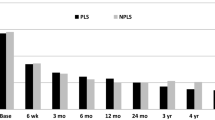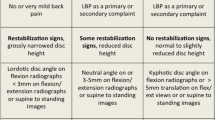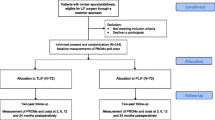Abstract
Purpose
The purpose of this study was to compare patient-reported outcomes (PROs), morbidity, and costs of TLIF vs PLF to determine whether one treatment was superior in the setting of single-level degenerative spondylolisthesis.
Methods
Patients undergoing TLIF or PLF for single-level spondylolisthesis were included for retrospective analysis. EQ-5D, ODI, SF-12 MCS/PCS, NRS-BP/LP scores were collected at baseline and 24 months after surgery. 90-day post-operative complications, revision surgery rates, and satisfaction scores were also collected. Two-year resource use was multiplied by unit costs based on Medicare payment amounts (direct cost). Patient and caregiver workday losses were multiplied by the self-reported gross-of-tax wage rate (indirect cost). Total cost was used to assess mean total 2-year cost per QALYs gained after surgery.
Results
62 and 37 patients underwent TLIF and PLF, respectively. Patients in the PLF group were older (p < 0.01). No significant differences were seen in baseline or 24-month PROs between the two groups. There was a significant improvement in all PROs from baseline to 24 months after surgery (p < 0.001). Both groups had similar rates of 90-day complications, revision surgery, satisfaction, and similar gain in QALYs and cost per QALYs gained. There was no significant difference in 24-month direct, indirect, and total cost.
Conclusions
Overall costs and health care utilization were similar in both the groups. Both TLIF and PLF for single-level degenerative spondylolisthesis provide improvement in disability, pain, quality of life, and general health.
Similar content being viewed by others
References
Herkowitz HN, Kurz LT (1991) Degenerative lumbar spondylolisthesis with spinal stenosis. A prospective study comparing decompression with decompression and intertransverse process arthrodesis. J Bone Jt Surg Am 73:802–808
Ghogawala Z, Dziura J, Butler WE, Dai F, Terrin N, Magge SN, Coumans JV, Harrington JF, Amin-Hanjani S, Schwartz JS, Sonntag VK, Barker FG 2nd, Benzel EC (2016) Laminectomy plus fusion versus laminectomy alone for lumbar spondylolisthesis. N Engl J Med 374:1424–1434. doi:10.1056/NEJMoa1508788
Kepler CK, Vaccaro AR, Hilibrand AS, Anderson DG, Rihn JA, Albert TJ, Radcliff KE (2014) National trends in the use of fusion techniques to treat degenerative spondylolisthesis. Spine (Phila Pa 1976) 39:1584–1589. doi:10.1097/brs.0000000000000486
Pannell WC, Savin DD, Scott TP, Wang JC, Daubs MD (2015) Trends in the surgical treatment of lumbar spine disease in the United States. Spine J 15:1719–1727. doi:10.1016/j.spinee.2013.10.014
Norton RP, Bianco K, Klifto C, Errico TJ, Bendo JA (2015) Degenerative spondylolisthesis: an analysis of the nationwide inpatient sample database. Spine (Phila Pa 1976) 40:1219–1227. doi:10.1097/brs.0000000000000987
Suk SI, Lee CK, Kim WJ, Lee JH, Cho KJ, Kim HG (1997) Adding posterior lumbar interbody fusion to pedicle screw fixation and posterolateral fusion after decompression in spondylolytic spondylolisthesis. Spine (Phila Pa 1976) 22:210–219 (discussion 219–220)
McAfee PC, DeVine JG, Chaput CD, Prybis BG, Fedder IL, Cunningham BW, Farrell DJ, Hess SJ, Vigna FE (2005) The indications for interbody fusion cages in the treatment of spondylolisthesis: analysis of 120 cases. Spine (Phila Pa 1976) 30:S60–S65
Bydon M, Macki M, Abt NB, Witham TF, Wolinsky JP, Gokaslan ZL, Bydon A, Sciubba DM (2015) The cost-effectiveness of interbody fusions versus posterolateral fusions in 137 patients with lumbar spondylolisthesis. Spine J 15:492–498. doi:10.1016/j.spinee.2014.10.007
Macki M, Bydon M, Weingart R, Sciubba D, Wolinsky JP, Gokaslan ZL, Bydon A, Witham T (2015) Posterolateral fusion with interbody for lumbar spondylolisthesis is associated with less repeat surgery than posterolateral fusion alone. Clin Neurol Neurosurg 138:117–123. doi:10.1016/j.clineuro.2015.08.014
McAnany SJ, Baird EO, Qureshi SA, Hecht AC, Heller JG, Anderson PA (2016) Posterolateral fusion versus interbody fusion for degenerative spondylolisthesis: a systematic review and meta-analysis. Spine (Phila Pa 1976). doi:10.1097/brs.0000000000001638
Baker JF, Errico TJ, Kim Y, Razi A (2017) Degenerative spondylolisthesis: contemporary review of the role of interbody fusion. Eur J Orthop Surg Traumatol 27:169–180. doi:10.1007/s00590-016-1885-5
Christensen A, Hoy K, Bunger C, Helmig P, Hansen ES, Andersen T, Sogaard R (2014) Transforaminal lumbar interbody fusion vs. posterolateral instrumented fusion: cost-utility evaluation alongside an RCT with a 2-year follow-up. Eur Spine J 23:1137–1143. doi:10.1007/s00586-014-3238-6
Lebow R, Parker SL, Adogwa O, Reig A, Cheng J, Bydon A, McGirt MJ (2012) Microdiscectomy improves pain-associated depression, somatic anxiety, and mental well-being in patients with herniated lumbar disc. Neurosurgery 70:306–311. doi:10.1227/NEU.0b013e3182302ec3 (discussion 311)
Main CJ, Wood PL, Hollis S, Spanswick CC, Waddell G (1992) The distress and risk assessment method. A simple patient classification to identify distress and evaluate the risk of poor outcome. Spine (Phila Pa 1976) 17:42–52
Main CJ (1983) The modified somatic perception questionnaire (MSPQ). J Psychosom Res 27:503–514
Fairbank JC, Pynsent PB (2000) The Oswestry Disability Index. Spine (Phila Pa 1976) 25:2940–2952 (discussion 2952)
Langley GB, Sheppeard H (1985) The visual analogue scale: its use in pain measurement. Rheumatol Int 5:145–148
EuroQol (1990) A new facility for the measurement of health-related quality of life. Health Policy (Amst, Neth) 16:199–208
Ware J Jr, Kosinski M, Keller SD (1996) A 12-Item Short-Form Health Survey: construction of scales and preliminary tests of reliability and validity. Med Care 34:220–233
Daltroy LH, Cats-Baril WL, Katz JN, Fossel AH, Liang MH (1996) The North American spine society lumbar spine outcome assessment Instrument: reliability and validity tests. Spine (Phila Pa 1976) 21:741–749
Parker SL, Godil SS, Shau DN, Mendenhall SK, McGirt MJ (2013) Assessment of the minimum clinically important difference in pain, disability, and quality of life after anterior cervical discectomy and fusion: clinical article. J Neurosurg Spine 18:154–160. doi:10.3171/2012.10.spine12312
Copay AG, Glassman SD, Subach BR, Berven S, Schuler TC, Carreon LY (2008) Minimum clinically important difference in lumbar spine surgery patients: a choice of methods using the Oswestry Disability Index, Medical Outcomes Study questionnaire Short Form 36, and pain scales. Spine J 8:968–974. doi:10.1016/j.spinee.2007.11.006
Parker SL, Adogwa O, Paul AR, Anderson WN, Aaronson O, Cheng JS, McGirt MJ (2011) Utility of minimum clinically important difference in assessing pain, disability, and health state after transforaminal lumbar interbody fusion for degenerative lumbar spondylolisthesis. J Neurosurg Spine 14:598–604. doi:10.3171/2010.12.spine10472
Parker SL, Fulchiero EC, Davis BJ, Adogwa O, Aaronson OS, Cheng JS, Devin CJ, McGirt MJ (2011) Cost-effectiveness of multilevel hemilaminectomy for lumbar stenosis-associated radiculopathy. Spine J 11:705–711. doi:10.1016/j.spinee.2011.04.024
Devin CJ, Chotai S, Parker SL, Tetreault L, Fehlings MG, McGirt MJ (2015) A cost-utility analysis of lumbar decompression with and without fusion for degenerative spine disease in the elderly. Neurosurgery 77(suppl 4):S116–S124. doi:10.1227/neu.0000000000000949
Chotai S, Sielatycki JA, Parker SL, Sivaganesan A, Kay HL, Stonko DP, Wick JB, McGirt MJ, Devin CJ (2016) Effect of obesity on cost per quality adjusted life years gained following anterior cervical discectomy and fusion in elective degenerative pathology. Spine J. doi:10.1016/j.spinee.2016.06.023
Bala MM, Riemsma RP, Nixon J, Kleijnen J (2008) Systematic review of the (cost-)effectiveness of spinal cord stimulation for people with failed back surgery syndrome. Clin J Pain 24:741–756. doi:10.1097/AJP.0b013e318179032a
Adogwa O, Parker SL, Shau DN, Mendenhall SK, Aaronson O, Cheng JS, Devin CJ, McGirt MJ (2012) Cost per quality-adjusted life year gained of revision neural decompression and instrumented fusion for same-level recurrent lumbar stenosis: defining the value of surgical intervention. J Neurosurg Spine 16:135–140. doi:10.3171/2011.9.spine11308
Adogwa O, Parker SL, Shau DN, Mendenhall SK, Devin CJ, Cheng JS, McGirt MJ (2012) Cost per quality-adjusted life year gained of laminectomy and extension of instrumented fusion for adjacent-segment disease: defining the value of surgical intervention. J Neurosurg Spine 16:141–146. doi:10.3171/2011.9.spine11419
Parker SL, Adogwa O, Bydon A, Cheng J, McGirt MJ (2012) Cost-effectiveness of minimally invasive versus open transforaminal lumbar interbody fusion for degenerative spondylolisthesis associated low-back and leg pain over two years. World Neurosurg 78:178–184. doi:10.1016/j.wneu.2011.09.013
Hoy K, Bunger C, Niederman B, Helmig P, Hansen ES, Li H, Andersen T (2013) Transforaminal lumbar interbody fusion (TLIF) versus posterolateral instrumented fusion (PLF) in degenerative lumbar disorders: a randomized clinical trial with 2-year follow-up. Eur Spine J 22:2022–2029. doi:10.1007/s00586-013-2760-2
Hoy K, Truong K, Andersen T, Bunger C (2016) Addition of TLIF does not improve outcome over standard posterior instrumented fusion. 5–10 years long-term Follow-up: results from a RCT. Eur. Spine. doi:10.1007/s00586-016-4592-3
Ha KY, Na KH, Shin JH, Kim KW (2008) Comparison of posterolateral fusion with and without additional posterior lumbar interbody fusion for degenerative lumbar spondylolisthesis. J Spinal Disord Tech 21:229–234. doi:10.1097/BSD.0b013e3180eaa202
Even JL, Chen AF, Lee JY (2014) Imaging characteristics of “dynamic” versus “static” spondylolisthesis: analysis using magnetic resonance imaging and flexion/extension films. Spine J 14:1965–1969. doi:10.1016/j.spinee.2013.11.057
Schroeder GD, Kepler CK, Kurd MF, Vaccaro AR, Hsu WK, Patel AA, Savage JW (2015) Rationale for the surgical treatment of lumbar degenerative spondylolisthesis. Spine (Phila Pa 1976) 40:E1161–E1166. doi:10.1097/brs.0000000000001116
Harms JG, Jeszenszky D (1998) Die posteriore, lumbale, interkorporelle fusion in unilateraler transforaminaler Technik. Oper Orthop Traumatol 10:90–102. doi:10.1007/s00064-006-0112-7
Humphreys SC, Hodges SD, Patwardhan AG, Eck JC, Murphy RB, Covington LA (2001) Comparison of posterior and transforaminal approaches to lumbar interbody fusion. Spine (Phila Pa 1976) 26:567–571
Yan DL, Pei FX, Li J, Soo CL (2008) Comparative study of PILF and TLIF treatment in adult degenerative spondylolisthesis. Eur Spine J 17:1311–1316. doi:10.1007/s00586-008-0739-1
Fujimori T, Le H, Schairer WW, Berven SH, Qamirani E, Hu SS (2015) Does transforaminal lumbar interbody fusion have advantages over posterolateral lumbar fusion for degenerative spondylolisthesis? Global Spine J 5:102–109. doi:10.1055/s-0034-1396432
Kitchen WJ, Mohamed M, Bhojak M, Wilby M (2016) Neurogenic claudication secondary to degenerative spondylolisthesis: Is fusion always necessary? Br J Neurosurg 30:662–665. doi:10.1080/02688697.2016.1206181
Austevoll IM, Gjestad R, Brox JI, Solberg TK, Storheim K, Rekeland F, Hermansen E, Indrekvam K, Hellum C (2017) The effectiveness of decompression alone compared with additional fusion for lumbar spinal stenosis with degenerative spondylolisthesis: a pragmatic comparative non-inferiority observational study from the Norwegian Registry for Spine Surgery. Eur Spine J 26:404–413. doi:10.1007/s00586-016-4683-1
Author information
Authors and Affiliations
Corresponding author
Ethics declarations
Conflict of interest
There are no conflicts of interest to disclose and no outside sources of funding were received for this study. This study was approved by the institutional review board (IRB). The manuscript submitted does not contain information about medical device(s)/drug(s).
Electronic supplementary material
Below is the link to the electronic supplementary material.
Rights and permissions
About this article
Cite this article
Kim, E., Chotai, S., Stonko, D. et al. A retrospective review comparing two-year patient-reported outcomes, costs, and healthcare resource utilization for TLIF vs. PLF for single-level degenerative spondylolisthesis. Eur Spine J 27, 661–669 (2018). https://doi.org/10.1007/s00586-017-5142-3
Received:
Revised:
Accepted:
Published:
Issue Date:
DOI: https://doi.org/10.1007/s00586-017-5142-3




